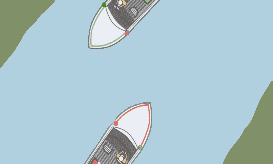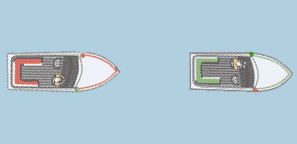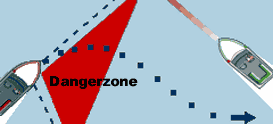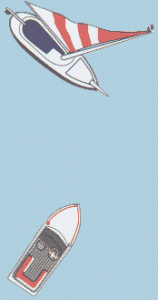Rules of the Road – The International Regulations for the Prevention of Collision at Sea
Boating KnowledgeOr IRPCS for short! The International Regulations for the Prevention of Collision at Sea are a set of rules that apply to all vessels using the sea be they commercial or leisure and all water users are obliged to observe them.
The most important aspect of the “Col Regs” is to maintain a good look out at all times. The skipper is responsible for keeping a lookout for dangers, be aware of the boating environment especially in bad weather, restricted visibility or darkness.
The full set of regulations can be downloaded as a pdf file -IRPCS
Is there a ‘right of way’?
In reality, vessels are either referred to as “Stand On” or “Give Way”. The “Stand On” vessel is required under the regulations to maintain its course and speed while the “Give Way” vessel is required to take such action as will be deemed appropriate to avoid a collision. In general terms however, the adage “Power gives way to Sail” is the basic principle. There are circumstances where this rule does not apply and more detailed reading of the regulations will make this clear.
It is not the intent of this site to provide a definitive interpretation of each rule as it would take a web site in its own right. However, we have shown a range of situations relative to the use of small craft operation.
Power driven vessels
Direction of travel
 Pass “Port to Port” a vessel operating in a river or buoyed channel should with oncoming traffic keep to the starboard (right hand) side.
Pass “Port to Port” a vessel operating in a river or buoyed channel should with oncoming traffic keep to the starboard (right hand) side.
Overtaking
 The overtaking vessel is the “Give Way” vessel and should keep clear of the vessel it is overtaking. The boat being overtaken is the “Stand On” vessel and is required to maintain course and speed
The overtaking vessel is the “Give Way” vessel and should keep clear of the vessel it is overtaking. The boat being overtaken is the “Stand On” vessel and is required to maintain course and speed
Approaching another boat head on
 When two vessels are approaching one another head on, they should alter course to starboard (right) and pass as if they were operating in a river or channel. The alteration of course should be early, clear and substantial so the other vessel is fully aware of the action being taken.
When two vessels are approaching one another head on, they should alter course to starboard (right) and pass as if they were operating in a river or channel. The alteration of course should be early, clear and substantial so the other vessel is fully aware of the action being taken.
Power boats crossing
 A boat coming from your starboard (right) is the “Stand On” vessel and you should make a clear move to starboard and pass behind the other boat. Where a vessel is coming from your port (left) side then it is the “Give Way” vessel and should make the appropriate move. In the event that the give way vessel does not alter course then you should either slow down, stop or turn to starboard to avoid the collision. DO NOT turn to port!
A boat coming from your starboard (right) is the “Stand On” vessel and you should make a clear move to starboard and pass behind the other boat. Where a vessel is coming from your port (left) side then it is the “Give Way” vessel and should make the appropriate move. In the event that the give way vessel does not alter course then you should either slow down, stop or turn to starboard to avoid the collision. DO NOT turn to port!
Power gives way to sail
 Where a powerboat is approaching a sailing boat – irrespective of which side the yacht is – then the powerboat must act as the “Give Way” vessel and give the sailing boat clear passage. It is considered good seamanship for the powerboat to keep clear of the sailing boat so as to avoid the effects of its wash on the yacht, particularly in light winds.
Where a powerboat is approaching a sailing boat – irrespective of which side the yacht is – then the powerboat must act as the “Give Way” vessel and give the sailing boat clear passage. It is considered good seamanship for the powerboat to keep clear of the sailing boat so as to avoid the effects of its wash on the yacht, particularly in light winds.
